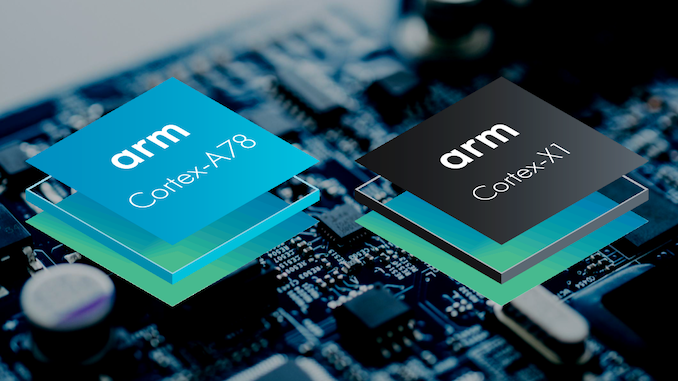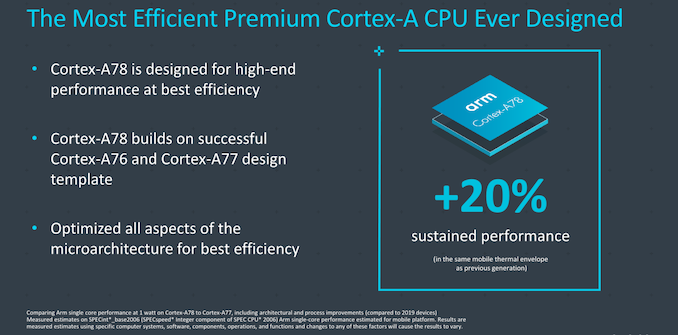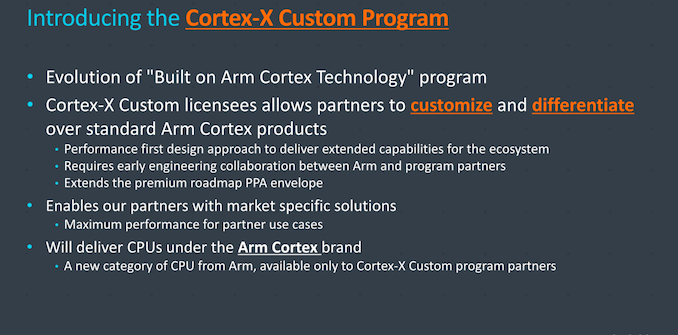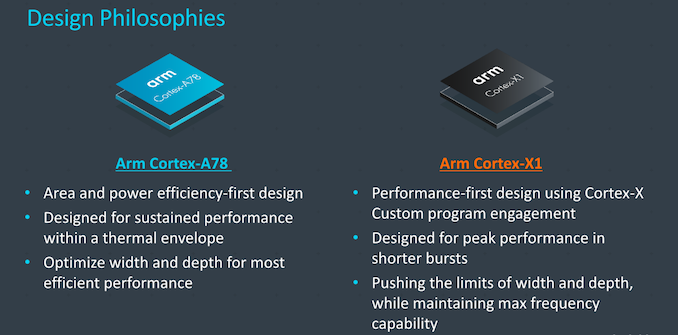Arm's New Cortex-A78 and Cortex-X1 Microarchitectures: An Efficiency and Performance Divergence
by Andrei Frumusanu on May 26, 2020 9:00 AM EST- Posted in
- SoCs
- CPUs
- Arm
- Smartphones
- Mobile
- GPUs
- Cortex
- Cortex A78
- Cortex X1
- Mali G78

2019 was a great year for Arm. On the mobile side of things one could say it was business as usual, as the company continued to see successes with its Cortex cores, particularly the new Cortex-A77 which we’ve now seen employed in flagship chipsets such as the Snapdragon 865. The bigger news for the company over the past year however hasn’t been in the mobile space, but rather in the server space, where one can today rent Neoverse-N1 CPUs such as Amazon’s impressive Graviton2 chip, with more vendors such as Ampere expected to release their server products soon.
While the Arm server space is truly taking off as we speak, aiming to compete against AMD and Intel, Arm hasn't reached the pinnacle of the mobile market – at least, not yet. Arm’s mobile Cortex cores have lived in the shadow of Apple’s custom CPU microarchitectures over the past several years, as Apple has seemingly always managed to beat Cortex designs by significant amounts. While there’s certainly technical reasons to the differences – it was also a lot due to business rationale on Arm’s side.
Today for Arm’s 2020 TechDay announcements, the company is not just releasing a single new CPU microarchitecture, but two. The long-expected Cortex-A78 is indeed finally making an appearance, but Arm is also introducing its new Cortex-X1 CPU as the company’s new flagship performance design. The move is not only surprising, but marks an extremely important divergence in Arm’s business model and design methodology, finally addressing some of the company’s years-long product line compromises.
The New Cortex-A78: Doubling Down on Efficiency
The new Cortex-A78 isn’t exactly a big surprise – Arm had first publicly divulged the Hercules codename over two years ago when they had presented the company’s performance roadmap through 2020. Two years later, and here we are, with the Cortex-A78 representing the third iteration of Arm’s new Austin-family CPU microarchitecture, which had started from scratch with the Cortex-A76.
The new Cortex-A78 pretty much continues Arm’s traditional design philosophy, that being that it’s built with a stringent focus on a balance between performance, power, and area (PPA). PPA is the name of the game for the wider industry, and here Arm is pretty much the leading player on the scene, having been able to provide extremely competitive performance at with low power consumption and small die areas. These design targets are the bread & butter of Arm as the company has an incredible range of customers who aim for very different product use-cases – some favoring performance while some other have cost as their top priority.
All in all (we’ll get into the details later), the Cortex-A78 promises a 20% improvement in sustained performance under an identical power envelope. This figure is meant to be a product performance projection, combining the microarchitecture’s improvements as well as the upcoming 5nm node advancements. The IP should represent a pretty straightforward successor to the already big jump that were the A76 and A77.
The New Cortex-X1: Breaking the Design Constraint Chains
Arm’s existing business model was aimed at trying to create a CPU IP that covers the widest range of customer needs. This creates the problem that you cannot hyper-focus on any one area of the PPA triangle without making compromises in the other two. I mentioned that Arm’s CPU cores have for years lived in the shadow of Apple’s CPU cores, and whilst for sure, the Apple's cores were technical superior, one very large contributing factor in Arm's disadvantage was that the business side of Arm just couldn’t justify building a bigger microarchitecture.
As the company is gaining more customers, and is ramping up R&D resources for designing higher performance cores (with the server space being a big driver), it seems that Arm has finally managed to get to a cross-over point in their design abilities. The company is now able to build and deliver more than a single microarchitecture per year. In a sense, we sort of saw the start of this last year with the introduction of the Neoverse-N1 CPU, already having some more notable microarchitectural changes over its Cortex-A76 mobile sibling.
Taking a quick look at the new Cortex-X1, we find the X1 higher up in Arm’s Greek pantheon family tree of CPU microarchitectures. Codenamed Hera, the design at least is named similarly to its Hercules sibling, denominating their close design relationship. The X1 is much alike the A78 in its fundamental design – in fact both CPUs were created by the same Austin CPU design team in tandem, but with the big difference that the X1 breaks the chains on its power and area constraints, focusing to get the very best performance with very little regard to the other two metrics of the PPA triangle.
The Cortex-X1 was designed within the frame of a new program at Arm, which the company calls the “Cortex-X Custom Program”. The program is an evolution of what the company had previously already done with the “Built on Arm Cortex Technology” program released a few years ago. As a reminder, that license allowed customers to collaborate early in the design phase of a new microarchitecture, and request customizations to the configurations, such as a larger re-order buffer (ROB), differently tuned prefetchers, or interface customizations for better integrations into the SoC designs. Qualcomm was the predominant benefactor of this license, fully taking advantage of the core re-branding options.
The new Cortex-X program is an evolution of the BoACT license, this time around making much more significant microarchitectural changes to the “base” design that is listed on Arm’s product roadmap. Here, Arm proclaims that it allows customers to customize and differentiate their products more; but the real gist of it is that the company now has the resources to finally do what some of its lead customers have been requesting for years.
One thing to note, is that while Arm names the program the “Cortex-X Custom Program”, it’s not to be confused with actual custom microarchitectures by vendors with an architectural license. The custom refers to Arm’s customization of their roadmap CPU cores – the design is still very much built by Arm themselves and they deliver the IP. For now, the X1 IP will also be identical between all licensees, but the company doesn’t rule out vendor-specific changes the future iterations – if there’s interest.
This time around Arm also maintains the marketing and branding over the core, meaning we’ll not be seeing the CPU under different names. All in all, the whole marketing disclosure around the design program is maybe a bit confusing – the simple matter of fact is that the X1 is simply another separate CPU IP offering by Arm, aimed at its leading partners, who are likely willing to pay more for more performance.
At the end of the day, what we're getting are two different microarchitectures – both designed by the same team, and both sharing the same fundamental design blocks – but with the A78 focusing on maximizing the PPA metric and having a big focus on efficiency, while the new Cortex-X1 is able to maximize performance, even if that means compromising on higher power usage or a larger die area.
It’s an incredible design philosophy change for Arm, as the company is no longer handicapped in the ultra-high-tier performance ring with the big players such as Apple, AMD, or Intel – all whilst still retaining their bread & butter design advantages for the more cost-oriented vendors out there who deliver hundreds of millions of devices.
Let’s start by dissecting the microarchitecture changes of the new CPUs, starting off with the Cortex-A78…














192 Comments
View All Comments
Kurosaki - Thursday, June 25, 2020 - link
It's the future!MarcGP - Tuesday, May 26, 2020 - link
You don't make any sense. You say at the same time :1) It's not a problem of the SOCs performance but of the poor emulation
2) The emulation software is not the issue but the weak SOCs
Make up your mind, it's one or the other, but it can't be both.
armchair_architect - Tuesday, May 26, 2020 - link
This looks pretty exciting!What if vendors will go for 2+4 configs (like Apple) with 2 X1 + 4 A78?
Apple has showed that this configuration is really good!
That would be a killer combinations as the littles are practically useless in real scenarios and a slow implementation of a A78 could very well cover the low part of the cluster DVFS curve, for idle.
A55 is super old and doesnt offer any useful performance, I suspect they are only there for the low-power scenarios.
But again, Apple has showed that its out-of-order little cores can be super efficient when implemented at low frequency (I think they run at something like 1.7GHz peak frequency).
I didnt read much information on X1 power, but yes it will for sure be less power efficient than A78 when both of them are running flat out at 3GHz. But, I highly suspect that (like A78 vs A77) on the whole DVFS curve, X1 can be lower power than A78 in the performance regions in which they overlap.
It is simply a matter of being wider and slower, this makes you more efficient. That is the Apple way, wide and slow.
They have the example of iso-performance metric, X1 will need much lower frequencies and voltages to reach a middle-of-the-road performance point (something like ~35 SpecInt, given that projection is 47 SpecInt flat-out). This could easily offset the intrinsic iso-frequency power deficit that the X1 brings.
spaceship9876 - Tuesday, May 26, 2020 - link
I'm surprised they are still using Arm v8.2, that was released in Jan 2016.Kamen Rider Blade - Tuesday, May 26, 2020 - link
I concur.In September 2019, ARMv8.6-A was introduced.
https://en.wikipedia.org/wiki/ARM_architecture#ARM...
There's also these new instructions to add in the future:
In May 2019, ARM announced their upcoming Scalable Vector Extension 2 (SVE2) and Transactional Memory Extension (TME)
eastcoast_pete - Tuesday, May 26, 2020 - link
I might be mistaken, but aren't those wide SVEs a co-development with Fujitsu? ARM might simply not have a blanket license to use that jointly developed tech. I am rooting for wider availability of those for my own reasons (video encoding runs much faster if it can use wide extensions). And there is no such thing as too much oomph for working with videos.SarahKerrigan - Tuesday, May 26, 2020 - link
It's just taking a while for SVE to get in. Future ARM Ltd cores are likely to have it; future server chips from Hisilicon are roadmapped to as well (although at this point, all bets are off due to the ongoing difficulties between the American state and Huawei.)GC2:CS - Tuesday, May 26, 2020 - link
So Apple is finally defeated now ?A11 was 25% A12 15% and A13 just 20% faster than last gen. So A10 is still quite competitive today.
This is higher gain than Apple for a third year in a row.
The question is, how much of that is won by going to the 5nm process ? I heard it is quite advanced compared to 7nm.
tipoo - Tuesday, May 26, 2020 - link
30% faster than the A77 will bring X1 closer to, but probably still under the A13. And A14 will be out by then. Wouldn't call Apple defeated yet, it's easier to make larger gains when you were at half their per core performance a few years ago...MarcGP - Wednesday, May 27, 2020 - link
30% faster in IPC gains alone (iso-process and frequency). The X1 SOCs will be much faster than that 30% over the current A77 SOCs, much closer to 50% than 30%.